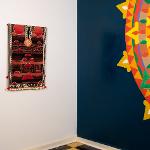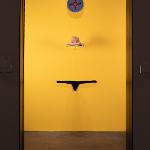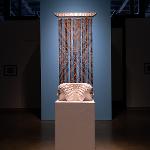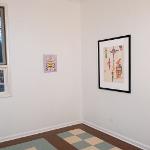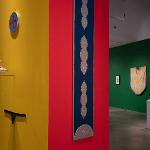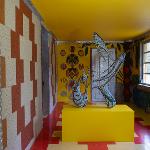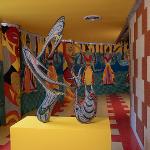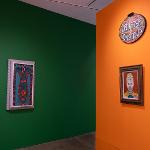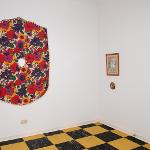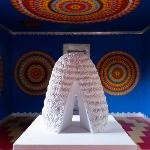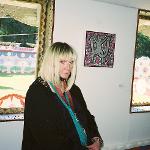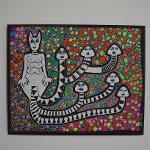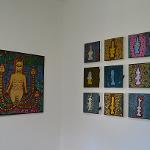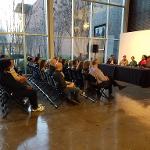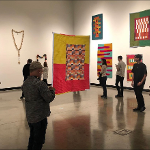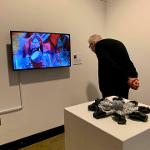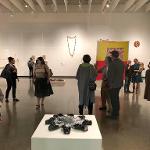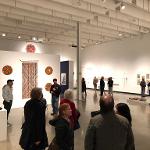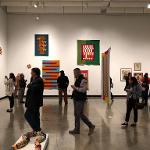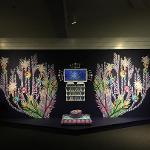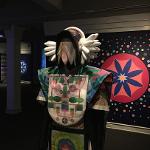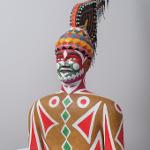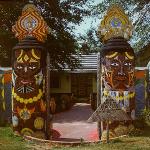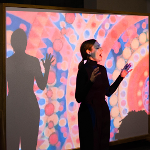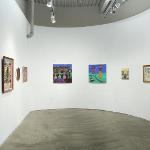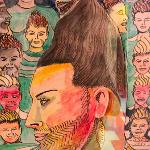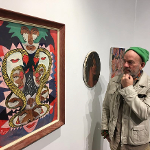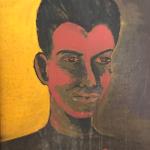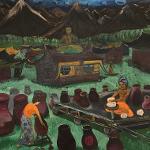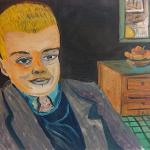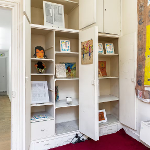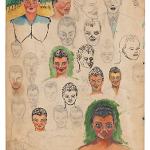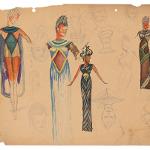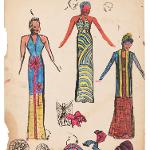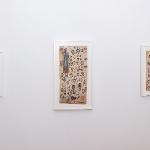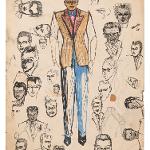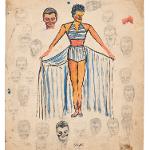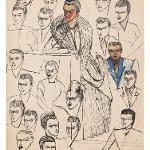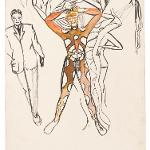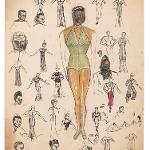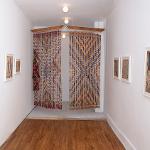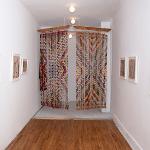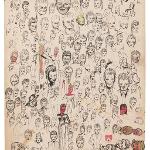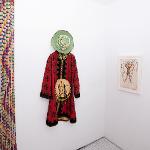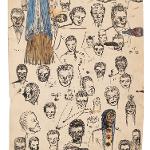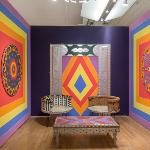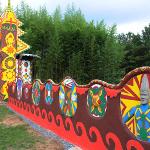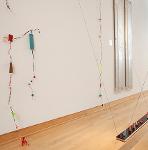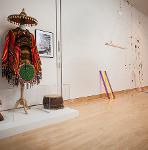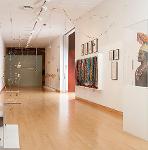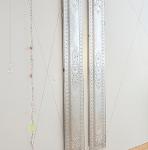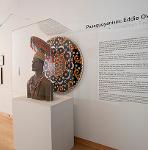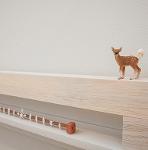Exhibitions
2025
Eddie Owens Martin, Drawing Between Worlds: St. EOM‘s New York Odyssey, 1930 - 1950
Eddie Owens Martin
Drawing Between Worlds: St. EOM‘s New York Odyssey, 1930 - 1950
November 8 - December 14, 2025
Curated by Michael McFalls & Charles Fowler
Director & Project Coordinator of Pasaquan
Opening Events: Saturday, Nov. 8, 4 - 6pm
4pm - Discussion with Michael McFalls, Charles Fowler & Annie Moye
5pm - Levitation Ceremony by Travis Dodd
Reception to follow until 6pm
Drawing Between Worlds: The Visionary Art of St. EOM
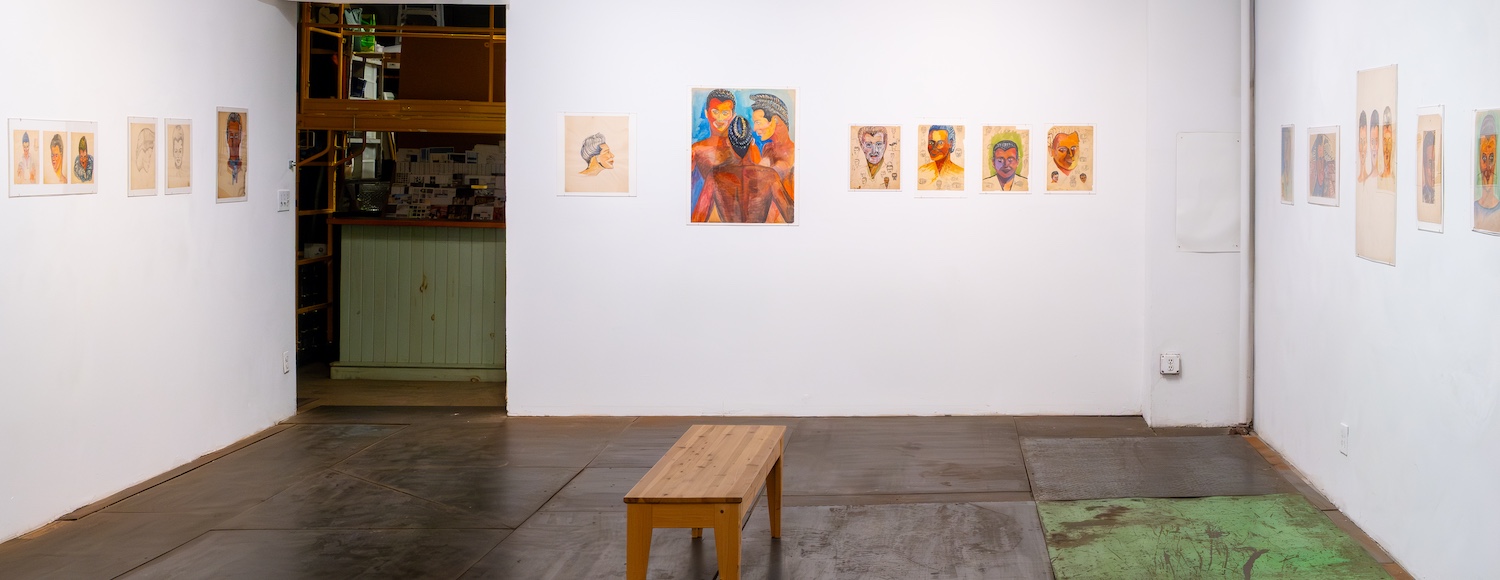
In the archives of Columbus State University (Columbus, GA), there are roughly 1,200 drawings made by Eddie Owens Martin. Many of these drawings were created while he was living in New York City from the 1930s through the mid-1950s. They are not studies or careful observational sketches but rapid notations of a cosmic development. They were created with the enthusiasm that I would associate with automatic writing or mediumistic drawing. Yet Martin was not channeling spirits in the traditional sense; he was birthing a universe, a utopian future, one drawing at a time. The drawings are divine. They are mantric. They are the visual equivalent of speaking in tongues. Martin was establishing his own world, where he could be himself. As a queer man in mid-century America, living on society‘s margins, each drawing represented independence from a world that offered little space to those who experienced visions and lived alternative lifestyles.
The materials themselves tell their own story—often just pencil or pen on whatever paper or cardboard scrap was available. These drawings were made in the margins of a marginal existence, squeezed between fortune-telling sessions and sex work, visions captured in rented rooms, borrowed spaces, or in his apartment when he was alone. Yet this material modesty only amplifies their power. Unencumbered by the preciousness of fine art materials or formal training, Martin was free to use drawing as a direct pipeline to his revelations.
The relationship between these drawings and Martin‘s first 1935 vision is important to address. During a near-death experience, he claims he encountered what he described as a massive deity-like figure who told him it was the end of the road for him unless he changed his ways. This encounter initiated his transformation into St. EOM, but it would take decades for Martin to fully comprehend the vision. The many New York drawings from the CSU archives can be understood as Martin‘s attempt to process this, to give form to what had been revealed to him in that liminal state between life and death. In these works, I observe the gradual evolution of the Pasaquoyan, the development of elaborate headdresses, cosmic beings, and guardian figures, which would later become the visual vocabulary of his 7-acre art environment in rural Marion County, Georgia.
There‘s an urgency to these drawings that you can‘t fake. The lines move as if Martin‘s hand were being guided by something faster than thought. This isn‘t careful rendering—it‘s channeling. The technical approach is revelatory: lines are swift but choppy. There‘s no labored modeling of form through shadow and light. Instead, Martin developed a kind of spiritual shorthand, a way of capturing essentials for the Pasaquoyan aesthetic. And yet, there‘s also incredible control here. Each mark knows exactly where it needs to be. The process of creating these works was both an escape from the constraints of everyday life and an affirmation of his spiritual vision.
These drawings function for Martin as an otherworldly technology. The lines have a vibrating quality, as if each stroke resonates with energy. The first time I saw them, I could sense the urgency behind each drawing. It‘s through this making process that Martin transforms his vision into a concrete and now shared perceptual experience. It is here that he brings the ethereal world of Pasaquan to life. Consider when you‘re trying to understand something complex—you might, as most artists do, diagram it out and sketch it repeatedly until it makes sense. Martin was doing that, but with an entire universe. These aren‘t studies for Pasaquan; they‘re the big bang where the Pasaquoyan is born, where the gender-fluid beings of the future are created, and the culture develops. All this makes sense if you consider his New York years. Martin moved through the city‘s underground cultures where identity was fluid, performed, and continually reinvented. The drag queens, hustlers, and outcasts who formed his community understood that identity was constructed rather than inherited. In drawing image after image, Martin was not simply observing this phenomenon but participating in it on an intense cosmic level. Each drawing represents both a shedding of Eddie Owens Martin and an emergence of St. EOM, the world‘s first Pasaquoyan.
The faces that dominate these drawings defy categorization. They are neither portraits of individuals nor generic types, but something altogether more androgynous—liminal figures echoing the fever dream works of Hieronymus Bosch or Frida Kahlo. They are fantastical and symbolic creatures, capturing an otherworldly and surreal quality. They feel deeply personal for Martin but are universally rich and resonant for us today. Some of Martin‘s faces stare out with eyes that see through time; others turn in profile, their features dissolving into patterns and symbols. At times, their hair rises to architectural heights; beards split and spiral up the sides of their faces and features multiply and merge. These are not depictions of people but possibilities; each Pasaquoyan is a meditation on what humans might become when freed from conventional limitations.
The dancers that appear throughout these works seem liberated from physical laws and at times sexual mores. Their bodies twist, elongate, and fragment, caught in movements that seem to originate from some unearthly choreography and unfamiliar sexual ecstasy. Arms multiply, torsos spiral, legs dissolve into rhythms pulsing from an unknown world. The Pasaquoyans, especially the dancers, remind me of (decades before he existed) Ziggy Stardust—psychedelic, androgynous, extraterrestrial. At times, these figures don‘t simply dance through space; they generate it, and in moments of cosmic sex, merge into one another, bodies caught in each other‘s gravitational pull.
After 14 years of looking at these drawings, years of returning to them, what still sometimes surprises me is their relationship to time. They‘re ancient and futuristic simultaneously, pulling from West African imagery and Native American patterns while invoking beings that seem to come from another galaxy. This scrambling of time is intentional for Martin. He understood something that physics is just catching up to: linear time might be an illusion, and past and future might be accessible together, if you know how to look and where to find it.
Unlike the permanent sculptures at Pasaquan, which were meant to endure, these works on paper and cardboard capture fleeting moments of vision. They possess the quality of dream journals, capturing images that might otherwise dissolve if not recorded quickly after a dream or vision. It was radical for St. EOM to create this work in New York during the 1930s, ‘40s, and ‘50s. While Abstract Expressionism explored existential, high modernist themes through paint-splattered canvases and color field meditations, Martin was in the Village envisioning entire civilizations and gender-fluid beings from the future. While the mainstream art world debated form and the picture plane, arguing over the flatness of the canvas and the purity of abstraction, Martin drew portals to another dimension. He wasn‘t interested in reducing art to its formal elements but in expanding it to encompass whole worlds, populated by beings who moved freely between genders, wearing elaborate headdresses and ceremonial garments that suggest rituals from civilizations yet to come.
This radical creativity is what moves me—what continues to draw me back after all these years. Every single drawing is an act of defiance against a world that wanted Eddie Owens Martin to disappear. As a queer man, as a fortune teller, as someone who claimed visions and spoke of alternate realities, St. EOM existed at the intersection of multiple taboos in mid-century America. There were numerous social agencies designed to force people like him into invisibility or conformity. But instead of disappearing, he transformed himself. Instead of being silenced, he created his own language. Instead of accepting the reality he was given, he drew new realities into existence. The repetition in these works—face after face, dancer after dancer—isn‘t redundancy. It‘s insistence. It‘s Martin saying: "This is real. This is real. This is real." Each iteration making solid what was once nonexistent.
Reflecting on my own moments of feeling outside, of not fitting in, I see in Martin‘s drawings a roadmap—not for escape, but for transformation. For artists like St. EOM, art is a cosmological construction. It‘s building the world you need to survive. Through the accumulation of drawn faces and figures, St. EOM was populating a universe, establishing its laws, and defining its inhabitants. The Pasaquoyan realm, which would later manifest as a vernacular art environment in rural Marion County, was first developed in these two-dimensional explorations, line by line, face by face.
In this exhibition, "Drawing Between Worlds," we get to see St. EOM in the act of becoming—not the stoic chief of Pasaquan but the searcher, the receiver, the vessel out of which these visions were drawn. These drawings are the record of the urgency of making. They remind me that creation isn‘t always pretty or precious—sometimes it‘s desperate and necessary. What these drawings reveal is that reality is more negotiable than we think, that identity is more fluid than we imagine, and that art can be a technology for accessing worlds we didn‘t know existed. St. EOM figured this out through his artistic practice. He lived it. These drawings are evidence.
- Michael McFalls is a professor of art at Columbus State University in Columbus, Georgia, and Director of Pasaquan.
Special thanks to Columbus State University, The Pasaquan Preservation Society and Ruth Arts for supporting this exhibition.
2023
Unstuck in Time: St. EOM, Pasaquan, Here, Now
"Unstuck in Time: St. EOM, Pasaquan, Here, Now" unites a diverse group of artists, carefully chosen not just for their visual resonance with St. EOM's work, but for their shared vision, dedication to their craft, and belief that art can transcend the present, opening portals to envision new possibilities and worlds.
This exhibition is curated by The Fuel and Lumber Company, founded by artists Amy Pleasant and Pete Schulte in Birmingham, Alabama, to facilitate exhibitions and related programming in the Southeast and beyond. Through their distinct artistic voices, these curators pay homage to the spirit of Pasaquan and St. EOM's profound artistic legacy. This exhibition celebrates the power of art to dissolve barriers, foster inclusivity, and spark conversations about the human condition, identity, and spirituality.
Participating Artists:
Ryan Akers, David Onri Anderson, Merrilee Challiss, Julia Elsas, Erik Frydenborg,
Leia Genis, Sonya Yong James, St. EOM (aka Eddie Owens Martin), Robert Morgan, New
Future City Radio (Damon Locks and Rob Mazurek), Sarah Peters, Sonic Mud (Julia Elsas,
Kenny Wollesen, Kirk Knuffke, Madeleine Ventrice), Sergio Suarez
2022
Jayne County Fantastic Penis Planet: The Feminization of the Male Organ
In 2021 I first curated this exhibition of works by Jayne County at Pasaquan, the otherworldly home, and artist-environment created by Eddie Owens Martin, or St. EOM. The pair were a match made in the Milky Way, two artists dreaming of distant worlds, persistently building places they could identify with. Creating meaning out of a society that could never wholly have sense. St. EOM took inspiration from “the ancients, the Assyrians, the Mayans, the Olmecs, the Egyptians, the people of Atlantis and Mu.” Jayne looks to ancient times, her sights set on the History Channel and hieroglyphics of ancient Egypt.
I think of these inspiring places, these moments in time, as giant projective masks that present our dreams of tomorrow. They are more often than not just ideas and ideals. They are like Rorschach tests, built on the fly with ambiguous materials to elicit interpretive responses from all onlookers. These artists, architects, world builders draw from life, from profound truths and reflections of the human condition, looking back at many yesterdays while dreaming of a more reassuring tomorrow. It’s a feeling so deep in the body that we often feel its only connection is somewhere out in the vastness of the cosmos, even if that celestial space is actually rural Georgia. Or maybe Egypt. Or perhaps even Kentucky.
But before tomorrow, we are here, brought together by Jayne County. In her world, all are welcome. County’s penis paintings are like nothing else comparable in contemporary art, but their inspiration works towards the same goals. At first blush, her paintings represent the unsayable, the unconscious, but we can all see ourselves on these canvases. The candor in these paintings is overdue and refreshing. Phallic hieroglyphs, repetitive symbols of who we once were, marks telling what we will be. Gone are any prudish impulses, replaced by conversations about the body in the world—ideas about fertility, gender ideals, identity, faith, morality—beliefs bigger than any of us. Their reflection back at us is pure and blazing. County has found this universal point of reference to use humor and skill to welcome us to her world. This is a safe space, an interstellar meeting house where all subjects, where all people are worthy of representation.
County’s stand-alone phalluses serve as carriers, transporters of meaning, representatives of a future phallocentric universe. The penises have invented a new language. They are dismembered members, equally free of sensuality or guilt. They are restless to the point of delirium. They glow with unearthly radiation; nebulae and star clusters guide their path. They are timeless. Seen together, her penises create a new pictographic language, a subversive radical nonverbal voice.
— Daniel Fuller, curator
Multitudes - American Folk Art Museum
A comprehensive way to understand Eddie Owens Martin’s many multitudes is through the artist’s concept of Pasaquoyan. This title refers both to a life philosophy and to a physical space for people to experience—a rhythmically colored seven-acre site in Georgia. Martin drew on a myriad of historical inspirations, including his limited knowledge from ancient Mesoamerican, Asian, and early Native North American civilizations. Like all religious prophets, Martin had a divine call that spurred him to do god’s will. An inner voice told him: “You’re gonna be the start of somethin’ new, and you’ll call yourself ‘Saint EOM,’ and you’ll be a Pasaquoyan, the first one in the world.” Developing his own belief system, he professed that pasa means “pass” in Spanish, and that quoyan is a term derived from an unidentified language that, according to St. EOM, meant “bringing the past and the future together.”
Martin’s spiritual belief system was both a personal manifesto and a performative practice, the full breadth of which is reflected in AFAM’s unique collection of his work. The drawings were created pre-Pasaquan in New York, where he supported himself as a sex worker, a fortune teller, and a waiter, absorbed in the art world, and relishing the company of drag queens, drug dealers, and other cultural outsiders who later found their ways into his works. His transitioning identity to St. EOM triggered the creation of a self-styled wardrobe, like often seen among creators of art environments, as a strategy to “dress the message or the messenger” and provide a sense of unity between art and life.
2020
Where Paradise Lay; Art and Southern Sanctuary” at the Kentucky Museum of Arts and Craft, Louisville, Kentucky
On view through November 8, 2020
Co-curated by Phillip March Jones and Joey Yates
Where Paradise Lay is an exhibition that takes inspiration from the book "Walks to the Paradise Garden," written by the poet, founder of the Jargon Society, and Black Mountain College alum, Jonathan Williams. Nearly thirty years after its completion in 1992, Institute 193 in Lexington, Kentucky published the text and images that chronicled Williams’ periodic journeys in the 1980’s and early 90’s with photographers Guy Mendes and Roger Manley as they searched for artists who, in Williams’ words, “live on the heath, amid the rhododendron and laurel and heather and sand myrtle—just like me.” The chronicle focused on a region “between Virginia and Louisiana, from the Ohio River to the Everglades.” Dozens of the artists profiled and documented during their trips have since been acquired by multiple U.S. institutions that include KMAC Museum, as well as the Metropolitan Museum in New York, the Smithsonian, and the High Museum in Atlanta. The High Museum adapted the Williams manuscript into an exhibition entitled Way Out There: The Art of Southern Backroads in early 2019 on the occasion of the first publication of Walks to the Paradise Garden, borrowing Mendes’ proposed, but rejected, title for the manuscript, "Way Out People Way Out There".
Due to the great efforts of advocates like former University of Kentucky art professor Michael Hall, who worked to include the Kentucky woodcarver Edgar Tolson in the 1973 Whitney Biennial, and New Museum founder Marcia Tucker, who included Howard Finster from Georgia in her exhibition for the American Pavilion at the 41st Venice Biennale in 1984, considerable attention had begun to be paid to these difficult to classify artists, despite their having been folded into the labels folk artist, outsider, self-taught, or visionary artist, a collection of terms intended to differentiate them from artists who were “trained” within an international system of university art programs.
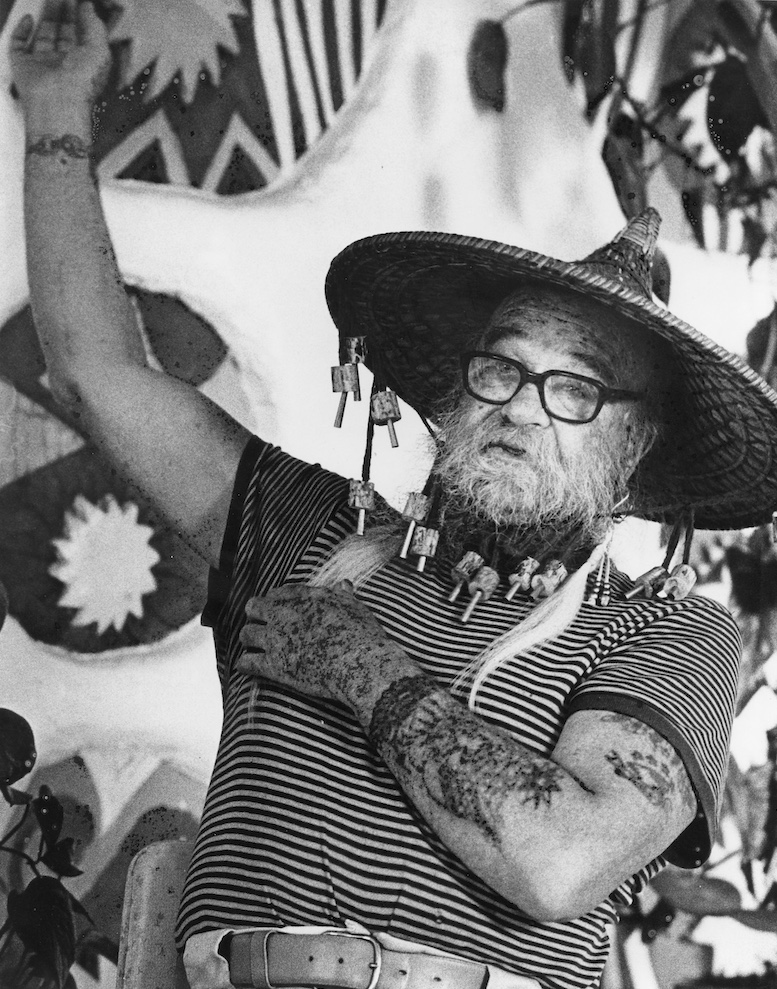
It was during this period that KMAC Museum itself was founded in 1981, originally as the Kentucky Art and Craft foundation, exhibiting traditional craft and folk artists from the region. A year later Jane Livingston and John Beardsley organized the seminal exhibition Black Folk Art in America, 1930-1980 at the Corcoran Gallery in Washington D.C. Two years after that, in 1984, Jonathan Williams made the first trip documented in the book. The 1970’s and 80’s were a fertile period when curators, writers, photographers and collectors like William Arnett were championing and exposing the exuberant, previously unheralded work that was being made by unknown artists throughout the American Southeast. As younger generations continue to synthesize the techniques and aesthetics displayed in the work of these artists, historians are more openly discussing the social and economic reasons for their remaining unknown for so long in the first place.
Where Paradise Lay looks at the late 20th century intrigue that flourished around this region, revisiting this museum’s own legacy in the history of collecting and exhibiting work from those who are, as Williams writes, “directly involved with making a paradise for themselves in the front yard, the back garden, the parlor, the sun porch, the basement.” KMAC Museum is now at the center of a discourse in contemporary art that places these artists in context with an increasingly global contemporary culture that looks to the Southern U.S. for inspiration. KMAC’s exhibition will reveal how artists, like those featured in the book "Walks to the Paradise Garden" - Howard Finster, Mary T. Smith, Thornton Dial, Ralph Griffin, Martha Nelson Thomas, Eddie Owens Martin, Edgar Tolson, and others - have helped to construct America’s artistic and cultural roots, shaping our country’s collective visual identity.
2019
Viberations of Pasaquan
Artists inspired by the art and legacy of Eddie Owens Martin exhibited with Eddie Owens Martin. Curated by Jonathan Fredrick Walz, and Michael Mcfalls.
Participating artists: Eddie Dominquez, Martha Clippingger, Gê Orthof, Saya Woolfalk, Charles Fowler, and Eddie Owens Martin
Saya Woolfalk: Augmented Visionary Reality Outpost
October 18, 2019 - February 2, 2020, Nordhausen/Callaway Galleries
Since 2006, Saya Woolfalk has been imagining and creating an alternative universe that combines science fiction, ceremonial ritual, technology, identity, and art. This other universe exists in the future and past simultaneously. Overall, Woolfalk’s ongoing project considers identities and influences across cultures, especially in relation to our contemporary world. Each museum that hosts one of the artist’s fantastical, immersive, multi-sensory installations helps continue and expand the story of this fictional world.
Woolfalk’s alternative universe is inhabited by beings from the future called the No Placeans. In the artist’s narrative, a group of modern-day women in Upstate New York stumbled on a set of No Placean bones covered in fungi. Over time, as the women were exposed to the bones, they experienced psychedelic visions, which in turn caused a genetic alteration that fused the women’s human DNA with that of plants. With this change in their DNA, the women renamed themselves the Empathics and set out to make this hybrid metamorphosis possible for anyone. They founded the Institute of Empathy to excavate the original archaeological site and then formed a corporation called ChimaTEK to sell this transformational process to consumers.
The environment in the Nordhausen Gallery tells the story of the ChimaCloud, the Empathics’ newest groundbreaking technology. This self-replicating digital universe is populated by fragments, ideas, and forms uploaded to the ChimaCloud by people from around the world. Woolfalk has reimagined the Callaway Gallery as a ChimaTEK day spa. It features three stations that foster mindfulness, guided meditation, and self-actualization for visitors.
By envisioning and then creating fully realized aspects of a fictional universe, Woolfalk intends to evoke not only wonder but also a feeling of disorientation. She hopes this combination of responses will lead to a sense of curiosity, openness, and possibility that visitors will then take with them into their everyday lives.
The original iteration of this project, Visionary Reality Outpost: Saya Woolfalk was organized by the John Michael Kohler Arts Center in Sheboygan, Wisconsin. Elements of Saya Woolfalk: Expedition to the ChimaCloud, recently on view at the Nelson-Atkins Museum of Art, are also featured here. The exhibition at The Columbus Museum has been made possible in part by the Columbus Convention and Visitors Bureau and the Columbus Cultural Arts Alliance.
As If: Alternative Histories from Then to Now
The Drawing Center
Apr 12–Jul 28, 2019
The works in multiple mediums in As If: Alternative Histories from Then to Now offer examples of how we might reimagine historical narratives in order to contend with the traumas of contemporary life. These works of consummate draftsmanship exemplify the skill of drawing and the imagination of artists at work turning fantasies into plausible realities—absurd, amusing, and sometimes terrifying. Whether exacerbating the contradictions of present society or imagining genuinely alternative utopias, the participating authors and artists traverse science fiction, popular culture, and genuine aesthetic thought-experiments. Spanning a historical era transformed by war, racial and economic inequity, authoritarianism, and the persistent fear of imminent apocalypse, these works offer alternative understandings of our present by rewiring the past.
History is always up for grabs. For centuries, writers, philosophers, and artists have speculated about historical narratives that run counter to actual historical events. What if, in 1859, John Brown’s successful raid on Harpers Ferry led to the establishment of a socialist nation called Nova Africa? What if, a few years later, in 1865, Susan B. Anthony became a gun-toting outlaw? A British General Strike in 1926 was a triumph? The Axis powers won World War II? Dewey defeated Truman? Raccoons or mosquitos evolved into the earth’s dominant species? Working towards utopian, reactionary, or simply ambiguous ends, the artists, writers, and amateur science fiction enthusiasts in this exhibition use the playground of history as a foundation on which to construct alternatives to the stark realities of the present—whether amplifying its inherent contradictions or imagining a better world.
Presented in As If: Alternative Histories from Then to Now are early speculative fiction publications from the mid 20th century, including the British wartime fanzine Futurian War Digest and ongoing science fiction magazine Interzone (1982–present), on loan from the Special Collections of the Albin O. Kuhn Library & Gallery, University of Maryland, Baltimore County. Book covers for Joanna Russ’s The Female Man, Philip K. Dick’s The Man in High Castle, Norman Spinrad’s Iron Dream, Martin Cruz Smith’s The Indians Won, and Ward Moore’s Bring the Jubilee are accompanied by album covers from the discography of Sun Ra and prints of Jack Kirby’s Lord of Light series, as well as the original ink drawing for the cover of Avengers #87, featuring Marvel’s T’Challa, the Black Panther, illustrated by John Buscema. These items are complemented by contemporary works on paper by artists including Huma Bhabha, Joe Bradley, Vivian Caccuri, Keith Mayerson, and Cauleen Smith.
Organized by Giampaolo Bianconi, guest curator, and Isabella Kapur, Curatorial Assistant, The Drawing Center.
The Drawing Center: As If: Alternative Histories from Then to Now
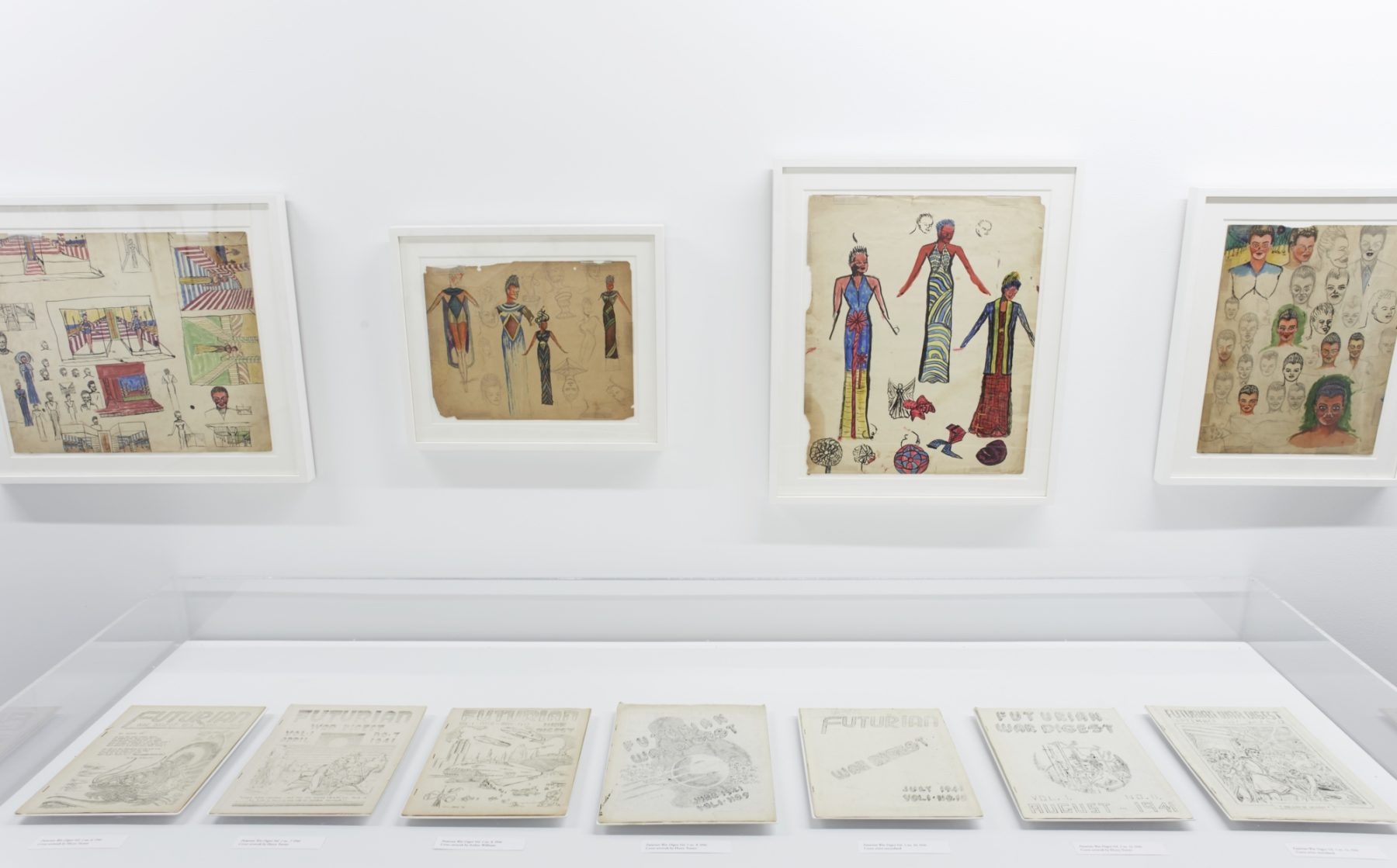
Way Out There: The Art of Southern Backroads
March 2 – May 19, 2019
In the early 1980s, poet Jonathan Williams invited photographers Guy Mendes and Roger Manley to hit the road “to document what tickled us, what moved us, and what (sometimes) appalled us in the Southeastern United States.” This exhibition brings to life their resulting encounters with self-taught artists who “make up beauty out of the air and out of nowhere,” such as Howard Finster, Mose Tolliver, Thornton Dial, and Mary T. Smith, along with dozens of others.
Williams had intended for Mendes’s and Manley’s photographs to illustrate the poetic, often humorous reflections he compiled into a guidebook—“a true Wonder Book, a guide for a certain kind of imagination.” He titled it Walks to the Paradise Garden to honor Finster and his Edenic art environment as well as the many other artists who were “directly involved with making paradise for themselves.”
For the first time, Way Out There brings together Mendes’s and Manley’s enthralling photographs, works in the High’s permanent collection by some of the artists they profiled, and excerpts from Williams’s book, which recently was published. This exhibition takes its name from a title Mendes preferred for the book, Way Out People Way Out There, which alludes to both the highly original mindsets of the featured artists as well as their geographical distance from conventional art-world capitals.
Way Out There: The Art of Southern Backroads - High Museum of Art
2018
Deep In The Woods - The Atlanta Contemporary
Deep in the woods of rural Marion County, Georgia, Eddie Owens Martin created one of the most important works of art in American history. Pasaquan is a seven-acre art environment that features an original farmhouse built in 1885, a ‘sitting room’, a sand-dance pit and a Kiva, a partially buried circular chamber designed for Pueblo Indian ceremonies. Utilizing a mélange of African, Polynesian, Easter Island, and Pre-Columbian symbolism Eddie painted a kaleidoscope of unholy visceral colors that blast off beneath the pines. The site effortlessly pushes and pulsates, if you embrace the psychic powers of the place, it feels like being transported inside of a Gauguin painting.
After Eddie passed on in 1986 the Pasaquan Preservation Society did their best to honor what he had left behind. After nearly 30 years The Kohler Foundation, a philanthropic organization, began bringing the site back to life. Today it is run by director Mike McFalls and caretaker Charles Fowler through the management of Columbus State University. Since the grand reopening Pasaquan was named one of the 16 intriguing things to see and do in the U.S. in 2016 by CNN.
After making the pilgrimage to Buena Vista it is easy to be seduced by the wild exterior of this mystical visionary environment. However, you would be doing yourself a disservice as inside Eddie’s former home there is a tremendous collection of paintings on canvas and paper bring jitters when I think about them. Long before Eddie began transforming the compound, he was a painter. For nearly 30 years he would faithfully spend mornings at the Metropolitan Museum of Art or the Museum of Natural History, looking, learning about an array of exotic cultures. He would tell fortunes in a Times Square tea room from 3pm until 10pm and then return to the St. James Hotel to paint thru the night. Much like Pasaquan the paintings are deep and lush, his cultural explorations are full of intense mystery. He illustrates magic lands with infinite possibilities. Mayans, Egyptians, and Polynesians are luxuriously dressed playing music in a field or making pottery on a stage. Young tarty male faces smile back at the viewer as they radiate love and joy via hypnotic hues that beam from all around them.
Eddie never received his due accolades for his paintings. Months after the Village Voice referred to him as “one of the most colorful registrants” at the annual Washington Square Outdoor Art Show, he returned to Buena Vista. Pasaquan itself is the centerpiece, but the paintings are the fine China orbing the table. They reinforce Eddie’s dreams and desires for refuge, an accepting place to escape to. Within these frames Eddie will forever be in motion.
History of the Soul at Paris Internationale
October 17, 2018 – October 21, 2018
Atlanta Contemporary will be exhibiting History of the soul, a collection of artworks compiled by Daniel Fuller, our curator, at to be shown at Paris Internationale. Paris Internationale is an annual art fair located in Paris, France, created in 2015 to showcase emerging galleries and artists.
History of the soul is based around the book Bobby, by Keith A. Smith. Created in 1983 and published by Nexus Press, Atlanta in 1985, Bobby is about a young boy’s solitude while remaining in the closet. The boy falls in love with his shadow, a black version of himself. The two are one, and yet forever forbidden. Forever one half of a whole, never able to live out loud. Living in the conservative America, there are frequent reminders that same-sex love interracial desires are around the corner; you just have to know which doors to open.
Five artists and a selection of a television program’s archives, art, and ephemera will occupy the space at Atlanta Contemporary’s booth and declare themselves present. Voices emerging from deep seclusion, however politically obscured or disembodied, announce their very existence with the greatest consequences.
This exhibition is located at 16 Rue Alfred de Vigny, 75008 Paris. Learn more about the Paris Internationale on their website.
Pasaquoyan in the City: Fashioning a Southern Saint
Eddie Owens Martin
Pasaquoyan in the City: Fashioning a Southern Saint
Curated by Annie Moye and Michael McFalls
September 26 – November 3, 2018
Institute 193 (1B), New York
Pasaquoyan in the City: Fashioning a Southern Saint, the inaugural exhibit at Institute 193’s East Village space, (1B), which opens on September 26, 2018, features a mostly never-before-seen collection of works by the late artist Eddie Owens Martin, or St. EOM, as he later called himself. Born in rural Marion County, Georgia, in 1908, Martin hitchhiked his way to New York City’s Greenwich Village at the age of fourteen to pursue a life of adventure, culture, and revelry that he couldn’t enjoy on his family’s farm back in the South. Supporting himself as a hustler, a fortune teller, and a waiter, he absorbed as much of the art world as he could and relished the company of drag queens, drug dealers, and other partiers, who later become the subjects in his drawings.
During an illness in 1935, Martin received his first vision from a futuristic, gender-bending alien who called on him to follow the “true way,” the path of a new religion called Pasaquoyanism. Martin agreed, became the world’s first Pasaquoyan, and began transitioning his identity from Eddie Owens Martin to St. EOM. St. EOM would remain in New York for twelve years, developing his spiritual belief system and honing his craft as a budding artist. Though he never received much recognition for his art in NYC, he continued to exhibit at small street festivals and was even featured in a short piece in the Village Voice in May 1957. By that time, however, the southern saint had had enough of the city and decided to return to his recently deceased mother’s farm outside of Buena Vista, Georgia.
There, he worked as a card reader—“the poor man’s psychiatrist,” he said—for members of the local community and began construction on his magnum opus, the seven-acre art environment he called Pasaquan, to which he would devote the last thirty years of his life. Today, thirty-two years after his death and two years removed from the completion of a major restoration project by the Kohler Foundation, Pasaquan is as vibrant and fascinating as ever. Owned and operated by Columbus State University, the site allows visitors to explore the “pre-Colombian, psychedelic wonderland,” as St. EOM’s biographer, Tom Patterson, once dubbed it, every weekend during the academic year. The drawings and sketchbooks presented in this exhibition were selected from a collection of 1200 drawings found in steamer trunks in an attic at Pasaquan.
These drawings have never been exhibited and were probably never removed from their trunks after Eddie moved back to Georgia from NYC. Many of the sketches recently saw the light of day after they were gifted to the Columbus State University Archives. The drawings selected reflect the time St. EOM spent in New York post-vision and pre-Pasaquan, as he was building his new identity and belief system and advancing his unique artistic style that has become so iconic.
Inspired by the eccentric characters and personalities he met in the city, St. EOM obsessively worked on portraits and fashion designs that often blurred the line between reality and Pasaquoyan fantasy. In these early drawings, one can sense the immediacy of his vision, the urgency of creation, and the depth of his passion. Primarily created between 1935 and 1957, these works reflect a saint-in-progress and an ideology in the making. The exhibit also features a peek into St. EOM’s self-styled and handmade wardrobe, including one of the extraordinary outfits he wore on the grounds of Pasaquan as a fully-fashioned southern saint.
Responding to Pasaquan was curated by Saya Woolfalk, Outsider Art Fair
Responding to Pasaquan was curated by Saya Woolfalk for the 2018 Outsider Art Fair, and was presented with support from the John Michael Kohler Art Center and Pasaquan at Columbus State University.
"Visionary Art is a grassroots form of self-expression and the ideas put forth by visionary artists can be powerful tools for imagining alternative realities.
In 1957, interracial marriage was illegal in twenty-four states in the United States, including Georgia. This was also the year Eddie Owens Martin (St. EOM) began to build Pasaquan, an elaborate complex of visionary art and architecture in Columbus, Georgia. St. EOM created a future utopian world called Pasaquan, in which all cultures and ethnic groups come together and connect with the earth and the universe.
He built a temple to a culturally hybridized world in a place and time when many Americans were violently unreceptive to this perspective. What compelled St. EOM to build such a complex? How was he able to project his progressive views into the imaginations of his neighbors and what methods did he use so they might consider his utopia?
My curated booth at the Outsider Art Fair is the first in a series of projects in which I engage St EOM’s ideas and work. The resulting installations are an attempt to understand the strategies St EOM used to communicate his vision of Pasaquan with the people of Columbus, Georgia. St. EOM engaged visitors with the use of fortune telling and astrology. The booth at the Outsider Art Fair is furnished with objects from St. EOM’s original fortune telling parlor. This includes mandalas borrowed from the John Michael Kohler Arts Center as the starting point for site-specific wall drawings and an unpainted bust from St. EOM’s workshop, which I will activate with video projections.
At the center of this installation is a piece developed with astrologer Alice Sparkly Kat. Audience members will be invited to have their charts read and participate in workshops that decolonize through astrology."
-Saya Woolfalk
St. EOM of Pasaquan - The Lyndon House Arts Center
The Lyndon House Arts Center is pleased to announce the new exhibition St. EOM of Pasaquan, and related events, a book signing with author Tom Patterson and the Pasaquan panel discussion.
Eddie Owens Martin, or St. EOM of Pasaquan, was a self-taught artist who, while living in his home town of Buena Vista, created a spectacular art site. Pasaquan, recently renovated and under the guidance of Columbus State University, is a unique and internationally recognized visionary art environment. Lyndon House Arts Center has the pleasure of filling the galleries with St. EOM’s numerous artworks from paintings, drawings, sculptures as well as garments and adornments.
We are happy to host author Tom Patterson, whose publication, St. EOM in the Land of Pasaquan: the life and times and art of Eddie Owens Martin, has just been re-printed by UGA Press. Tom Patterson will be in the gallery to sign copies on Thursday, November 8 beginning at 5:30 pm. Books are available for purchase that evening courtesy of Avid Bookshop.
The Pasaquan panel discussion welcomes Professor Michael McFalls, Columbus State University and Director of Pasaquan, historian Fred Fussell, the Pasaquan Preservation Society president, Annie Moye, Author Tom Patterson and others on Friday, November 9 at 1:00 pm. This panel will include the story of Pasaquan, the importance of preserving visionary art and its legacy as well as the wonderful tales of the extraordinary St. EOM from those who knew him well.
This exhibit and events are supported by the Willson Center for Humanities and Arts and the Public Impact Program, University of Georgia Press, LaGrange Art Museum, Columbus State University, Pasaquan Preservation Society, Michael Pierse, Pasaquan and Avid Booksellers.
In the Land of of Pasaquan: The Story of Eddie Owens Martin originated from the LaGrange Art Museum, and is made available by the courtesy of Columbus State University, Columbus State University Foundation, Inc., Pasaquan in Buena Vista, Georgia, and through a gift by the Kohler Foundation, Inc.
Lyndon House Arts Center, located at 211 Hoyt St in Athens GA, is a facility of the Athens-Clarke County Leisure Services Department and is supported in part by the Georgia Council for the Arts (GCA) through the appropriation of the Georgia General Assembly. GCA is a partner agency of the National Endowment for the Arts.
-Saya Woolfalk
St. EOM of Pasaquan | Athens-Clarke County, GA - Official Website
2017
Pasaquoyanism: Eddie Owens Martin+ Jonathan Frederick Walz+ Gê Orthof – John Michael Kohler Arts Center
In 1957, a Georgia native returned to his family home near Buena Vista and began constructing one of the most significant art environments in the U.S. Eddie Owens Martin (1908–1986), the son of sharecroppers, created a world called “Pasaquan” and an elaborate new religion, of which he was the sole practitioner.
When Martin was in his twenties, voices in a fevered vision told him he was to become a “Pasaquoyan” named St. EOM and instructed him to depict a peaceful future for humanity. The home and seven acres he inherited became that depiction.
Martin built fences, pagodas, shrines, altars, walls, and walkways and embellished them with brightly painted totem faces, whirling mandalas, undulating snakes, and variously styled figures. All of it bears Martin’s perceptions of pre-Columbian Mexican temples and the fabled lost continents of Mu and Atlantis.
This was the first exhibition showing of Martin’s works that were recently gifted to the Arts Center by Kohler Foundation, Inc. Among them were paintings, sketches, and the artist’s ceremonial garb.
Jonathan Frederick Walz, director of curatorial affairs and curator of American art at The Columbus Museum, collaborated on the exhibition. Walz gave broader context to St. EOM’s art environment by positioning it with the work of Brazilian artist Gê Orthof, who also creates immersive, site-specific installations based on place and the sensorial reactions a place evokes.
In 2008, Pasaquan was added to the National Register of Historic Places. In 2013, the Kohler Foundation, Inc. embarked on an extensive restoration of the site. The stewardship of Pasaquan is under the direction of nearby Columbus State University. A small number of St. EOM’s works of art are stored, conserved, and placed in museum collections by Kohler Foundation to ensure survival in the event that a natural disaster might cause extensive damage at the site.
We are deeply grateful for the generous support of these sponsors.

